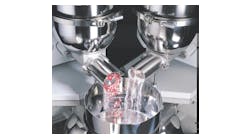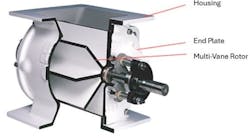Managing an efficient bulk material process requires attention to a long list of variables and small details. Any of them could negatively impact the overall effectiveness and ultimate profitability of an operation. Perhaps no single challenge is as out of sight as the impact of material "dusting" at a facility.
Benjamin Franklin once famously said, "Write your injuries in dust, your benefits in marble." While his comments were referring to highlighting one’s successes in life, the use of "injuries" and "dust" is very applicable when it comes to the challenges dusting presents to a bulk material operation. Here’s the good news: Finding success in the fight against dusting is within reach, and if obtained, the benefits would be worth commemorating in the finest marble.
Identifying the causes, implementing fixes and understanding the huge impact dusting can have on an operation’s bottom line is critical to addressing it — before it becomes a problem.
Challenges
The Occupational Safety and Health Administration (OSHA) recognizes the importance of controlling dusting and states:
Control of Fugitive Materials: Following the March 2008 update to the OSHA National Emphasis Program (NEP) regarding combustible dust, housekeeping procedures and prevention of dust accumulation have generated increased attention. OSHA has announced it will issue a citation for the presence of combustible dust, if dust accumulations exceed 1/32-inch deep (the thickness of a paper clip) and cover at least 5 percent of a room’s total area or 1,000 square feet. Accumulations on overhead beams, joists, ducts and the tops of equipment are included when determining the dust coverage area.
Compliance
Compliance with OSHA regulations is just one reason to get ahead of any dusting challenge. By controlling dusting at a facility, you can ensure compliance regulations are met. In addition to OSHA compliance, dust mitigation will improve worker safety, increase equipment reliability and longevity, and minimize unplanned maintenance and downtime, all while enhancing productivity and bolstering the bottom line.
Avoid waste
Controlling dust also increases material handling efficiency. Losing product to dust in the air that is eventually swept up or washed away during maintenance is effectively throwing money down the drain. The most efficient operations capture and use all of the material in every bag, container, silo or tank.
Safety
Dust associated with the movement and handling of materials such as sugar, starch and coal has properties that make it especially dangerous. The airborne dust of many products is flammable, and in many cases, it can cause an explosion.
The National Fire Protection Association (NFPA) 654 Standard for the Prevention of Fire and Dust Explosions from the Manufacturing, Processing, and Handling of Combustible Particulate Solid has had recent changes to the code to assist in the reduction of accidents associated with dusting. Secondary dust explosions, caused by airborne dust or excessive dust accumulations, have been responsible for much of the damage and casualties experienced in major industrial dust explosions.
Additionally, employees who work in environments impacted by dusting are far more likely to experience safety concerns from coated or slippery surfaces. Airborne dust increases the risks to employees for injuries or other ailments.
Control dust and bolster your bottom line by:
- Improving worker safety
- Ensuring compliance
- Increasing equipment reliability/longevity
- Minimizing maintenance/downtime
- Enhancing productivity
- Positively impacting profitability
Solutions
The threat dusting presents may be daunting, but there are solutions that help control dusting and mitigate the impact it can have on an operation. Whether it is the choice of conveyor implemented in the daily process or the key points of entry and exit for materials, there are ways to minimize the negative impact of dusting — and it starts with planning.
Conveyors
Because they offer a sealed line, the Tubular Drag, Flex Screw and En Masse conveyor solutions are all effective for confining material to the process and eliminating dust. These systems are often even more effective with the introduction of dust hoods and dust collection systems at the entry and exit points along the line.
Central dust collection systems
Comprised of larger, substantial dust collection equipment, these systems are an obvious solution for capturing and removing particulates from the plant environment or larger processes. The primary disadvantage is that these systems remove the material from your process. They are not cost-effective for small operations and may not always
adequately capture areas of concentrated dust in far corners of a facility.
An integral dust collector and bulk bag unloader work together to quickly discharge all material from the bag and eliminate dust.
Point-of-use collectors
These dust collectors are used in two primary scenarios. One is assembled on a hood, which can fit on an existing hopper or can be designed with an integral hopper. When ingredient bags are emptied, this integral dust collector immediately captures the airborne particulates on a cartridge filter. These units perform well with minor ingredient additions to a larger process, or in operations utilizing 20- to 50-lb. bags of material.
A side access door on a dust collector offers easy filter maintenance.
There are also integral dust collectors for bulk bag unloaders handling 2,000-lb. bags. Equipped with their own filters and bag spouts, these units catch the material and prevent it from seeping out when it is being dumped into the hopper. They also offer the added benefit of reusing expensive material that would be lost in a separate, free-standing collector. Timer-activated solenoid valves release short blasts of compressed plant air inside the cartridge filter(s), returning the dust buildup on the filter surfaces back into your process. These units are also placed directly on the inlets to other process equipment where it is desired to collect the dust from the unloading of bags.
Bulk bag unloaders and flexible screw conveyors confine material to the process and eliminate dust.
Conclusion
Dust control and risk mitigation go hand-in-hand for manufacturers that process dry powders and other bulk materials. By getting a handle on the challenge of dusting and implementing some of the innovative safeguards available, the risks can become rewards.
Craig Thomas is a product specialist with Hapman and is an authority in bulk bag handling and dust collection. He has more than 25 years of material handling experience and holds a degree from Indiana State University. For more on Hapman, visit hapman.com or call 800-427-6260.





